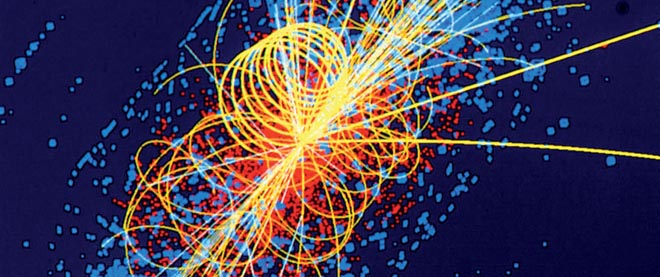Newsmakers 2012: Higgs & Kisses
Science’s big bet paid off when the ‘God particle’ was discovered courtesy of the monstrous Hadron Collider
Rex Features/CP
Share

Higgs boson
For nearly five decades, scientists have been searching for a missing piece of the universe—one that’s infinitesimally small, incredibly elusive, yet explains why everything as we know it exists. On July 4, an announcement came from Geneva, where the European Organization for Nuclear Research (CERN) is based: a team of thousands, working on a massive underground particle accelerator called the Large Hadron Collider, had confirmed the existence of the Higgs boson. The “God particle” had been found.
Named for theoretical physicist Peter Higgs, who dreamed it up in 1964, the Higgs boson particle has long been the missing piece of the Standard Model of particle physics, which describes the universe’s basic building blocks. It was Higgs’s answer to a question that had scientists stumped: where does mass come from? Mass gives shape to the universe, holding protons and neutrons together to make atoms, and then molecules, and then all of us. Higgs suggested particles obtain mass by passing through an invisible force field that stretches through the universe. “The [Higgs field] fills all of space,” says Neil Turok, director of the Perimeter Institute for Theoretical Physics in Waterloo, Ont. “It’s the medium in which we live,” and the Higgs boson particle is evidence of that field.
But Higgs particles aren’t floating all around us, and certainly aren’t easy to catch. When one pops into existence, it quickly decays into other particles, like photons (light particles). To produce a Higgs particle, scientists would have to “knock on the Higgs field” with a huge amount of energy crammed into a tiny amount of space, Turok says. So CERN’s $10-billion Large Hadron Collider was built, 100 m underground, at the Franco-Swiss border. There, proton beams race around a 27-km track, smashing into each other at incredible speeds and producing energy and new mass. Two teams, ATLAS and CMS—each made up of thousands of scientists from around the world—sifted through results of these collisions, searching for signs of the Higgs.
Click here for the interactive cover of the Newsmakers 2012 issue.
July’s news was greeted by cheers, tears, and celebration around the world. (When the announcement was made, 83-year-old Peter Higgs could be seen dabbing his eye.) Turok was at CERN shortly afterward to give a presentation. “The atmosphere was incredible,” he says. “Opening a new window on the universe—it’s thrilling.” But it isn’t just scientists who are excited, and the buzz hasn’t died down. In September, Carleton University hosted a public lecture about the Higgs, says physics professor Manuella Vincter, a scientist on the ATLAS team, along with about 150 Canadians. “We were turning people away. It was completely packed.”
Given this hubbub, there was some surprise when the Nobel Prize in Physics was announced in October—and it didn’t go to Peter Higgs. (Serge Haroche and David Wineland were awarded for their work in quantum optics.) “It would have been nice,” Vincter agrees, but the Large Hadron Collider is still collecting data, and she believes it makes sense to wait until more is known about this newly found particle. What’s more, nominations were due in February, when there were hints a Higgs discovery was on the horizon, but nothing more definite than that. Another complication: this prize can only be granted to three people or fewer, notes particle physicist Tim Meyer of TRIUMF, a Canadian physics lab at the University of British Columbia that collaborates with CERN. Yet thousands were involved in its discovery, not least of all Peter Higgs and five other theorists who published similar ideas around the same time. Nobel or not, discovering the Higgs boson has been called a once-in-a-generation scientific achievement.
Catching the Higgs boson is just the beginning. “We’ve never been so Higgs-crazy, but our focus is entirely different,” Vincter says. She and others are setting out to determine if this particle is indeed what the Standard Model predicted or something a little bit different. According to one theory, called “supersymmetry,” we might expect to find not one Higgs boson, but several. Affectionately nicknamed “SUSY” (and pronounced “Suzy”) by theorists, this suggests every known particle has a partner particle that’s still unknown, in which case there are plenty more discoveries to be made. The Higgs boson might even give us a way to explore hidden, alternate dimensions. “Maybe this particle is interacting with something in more than four dimensions,” Meyer says. “That would be pretty phenomenal.”
Since July 4, teams at the Large Hadron Collider have collected four times as much data as they did in the first half of 2012. They’re furiously taking in as much new information as they can, because in early 2013, the particle accelerator will be shut down for more than a year for maintenance. When it starts running again, in late 2014, it will be almost twice as powerful as it is today.
In the meantime, scientists are still permitting themselves moments to appreciate the Higgs discovery. “It’s incredible that several people in the early 1960s anticipated this particle was there,” Turok says. “Fifty years later, the greatest experiment ever conducted looks just where they thought it would be—and bingo! There it is.”